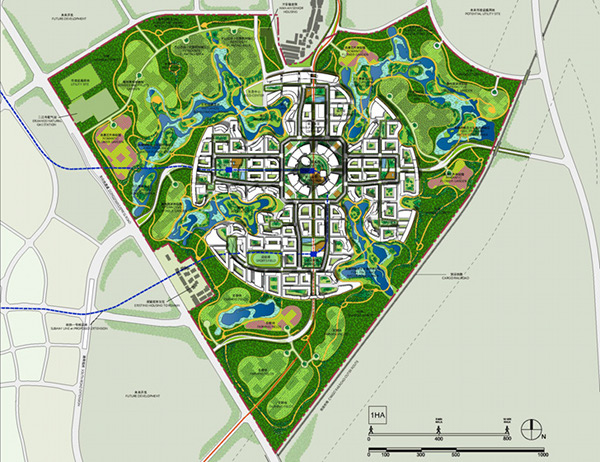China has long been considered an enigma in the West. You could say this enigmatic profile has extended, in recent years, to the country’s stance with regard to the environment. On the one hand, the legendary pollution of cities like Lanzhou and Beijing — and the country’s lax standards on e-waste recycling, among other things — paint a picture of a developing nation with little regard for either the natural environment or human health.
On the other hand, China’s adoption of renewable energy has earned it the number one spot in clean tech investing worldwide. (In the second quarter of 2012, China was the main contributor to a 24 percent increase in new global investment in the clean energy market largely due to hundreds of millions of dollars in financing of new wind and solar projects.) And then there’s that whole bullet train thing.

Now, in a development from the greener side of China, the Chinese government is working with Chicago-based Adrian Smith + Gordon Gill Architecture to develop a self-sustaining, environmentally sensitive 1.3-square-kilometer satellite city outside Chengdu. The master plan for Chengdu Tianfu District Great City (which comes to us via Inhabitat) was developed to offer a solution to the problems of overburdened infrastructure and high pollution levels that plague many of China’s major urban centers.
One of the first projects of its kind to be proposed or completed in China, Great City—developed by Beijing Vantone Real Estate Co., Ltd.—was envisioned as a prototype to be replicated in other locations throughout the country. The development is intended to respond to the problem of overburdened infrastructure in many of China’s major urban centers without contributing to the high energy consumption and carbon emissions associated with suburban sprawl.
An aerial blueprint of Great City reveals that the distance from any location in the city to any other location will be a 15 minute walk, all but eliminating the need for most automobiles. Another key to the city’s low-carbon profile is the fact that it will be built around a regional transit hub connecting Great City to Chengdu and surrounding areas via mass transit (though the goal is to have most of the people who will live in Great City work there as well).

Energy efficient green building techniques will be the norm in this development, as will the use of renewable energy for power. All told, the architects behind this project expect Great City to use 48 percent less energy and 58 percent less water than a conventional development housing a similar number of people. Great City will also produce 89 percent less landfill waste and generate 60 percent less carbon dioxide than its conventional equivalent.
Great City takes into account the larger issues affecting the sustainability of neighborhoods and cities as a whole — for instance, by surrounding this 320-acre urbanized area with 480-acre buffer landscape. This natural landscape, which includes valleys and bodies of water, will be integrated into the city itself while helping to separate it from other local developments. Employing a true “master plan,” Great City will boast a precise ratio of buildings to green space to roads and streets — specifically, 60 percent of the development will be earmarked for construction, 15 percent for parks and open space, and 25 percent will be devoted to infrastructure, roads and pedestrian streets.
Construction on the development is expected to begin this fall.